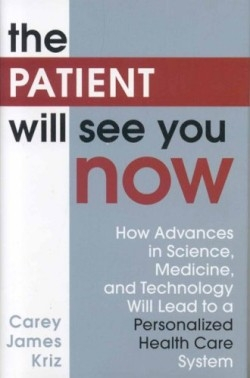The Patient Will See You Now
How Advances in Science Medicine and Technology Will Lead to a Personalized Health Care System
The cost of health care per American in 2007 was $7,600, and U.S. life expectancy has reached a record high of seventy-eight years, the National Coalition on Health Care states. Yet as costs rise, Americans still don’t live as long as people in many European countries or Japan, which spend far less on their citizens’ health. Carey James Kriz explores reasons behind this trend and reveals how he thinks the synthesis of information technology with advances in biomedical science will lead to a system of personalized health care (PHC) to improve health and reduce costs.
Kriz draws his ideas from decades of experience in both medicine and computers. He began his career at IBM, has been a member of the executive team at Johns Hopkins Medicine, and now heads the American Academy of Urgent Care Medicine. PHC, he says, is driven by better data gathering and better integration of knowledge about individual patients. These data equal a measure of health based on a function of genetics, actions, and environment.
Combining individual genetic information with a more complete medical history, Kriz says, could result in a highly efficient model of patient care. Furthermore, in a PHC system, these data could be analyzed by medical experts, consulting from a distance via the Internet—even in the operating room. “Where proximity was at one time the only reliable way of gleaning feedback from your colleagues, the future OR will likely include the ability to directly link experts from a dynamic electronic community,” he writes.
Hospitals, as they are currently configured, he says, will become obsolete. These “sacred” institutions will be replaced by a “collection of home-based technologies allowing you to perform real-time assessments with the results immediately embedded within your personal health record…[and]…automatically routed to the professionals.”
Some components of the author’s sweeping vision of the future of health care have already become reality—think of easily accessible devices such as the automatic external defribulater or the hand-held blood glucose monitor. This book is less prophetic than it is a well-researched analysis of an inevitable trend. However, the author’s point that the U.S. health system is due for revolution based on information harvested from the Human Genome Project hits home. Even if the upwards spiral in health care spending does not relent, perhaps personalized health care will help Americans achieve a “healthier” return on their investment.
Reviewed by
Mary Spiro
Disclosure: This article is not an endorsement, but a review. The publisher of this book provided free copies of the book to have their book reviewed by a professional reviewer. No fee was paid by the publisher for this review. Foreword Reviews only recommends books that we love. Foreword Magazine, Inc. is disclosing this in accordance with the Federal Trade Commission’s 16 CFR, Part 255.

